Podcast Episode Details
Back to Podcast Episodes
Equalizing Tech: Navigating the Gender Gap Amid AI's Rise
This is your Women in Business podcast.
Welcome back to Women in Business, where we spotlight stories, strategies, and real talk from the front lines of innovation. Today, let’s jump right into the crucial topic of women navigating the current economic landscape, with a special focus on the tech industry—a sector pulsing with both opportunity and challenge.
First, the hard truth: despite making up nearly half of the global workforce, women fill only about 27% of tech roles in the United States, according to CompTIA’s latest report. Looking closer, only around 17% of technology companies have a woman CEO, and just 14% of global tech leaders are women, based on findings from the Nash Squared Digital Leadership Report. The gender gap remains stark, but not unmovable.
Economic conditions are shifting fast—AI is booming, markets are volatile, and the pace of change is breakneck. When I think about opportunity, I’m reminded of McKinsey & Company’s estimate: closing the global gender gap in tech could add an astonishing $12 trillion to global GDP by 2025. That’s empowerment on a scale that benefits everyone.
But for now, let’s talk about navigating the realities in tech. One of the top challenges is retention. Around half of all women who enter the tech sector leave by the age of 35. The “Why?” is clear in the data and in the stories women share: lack of advancement, the “missing middle” where career momentum stalls, and burnout. The annual Women in Digital Report out of Australia calls out how mid-career women in tech often lose traction not because they lack drive, but because company structures still aren’t built for realities like caregiving. Support for flexible work is progressing, but we need more than token change.
Second, pay and leadership remain sticking points. While the gap has narrowed in some roles—female computer programmers now earn 94% of what men do—the median US tech salary is over $104,000, meaning every dollar counts. And yes, pay is still lagging for female CEOs at startups by about $20,000 compared to male peers, according to StrongDM. That’s real money and real impact.
Third, let’s discuss the skills of the future. Skillsoft’s 2024 report spotlights how AI proficiency is fast becoming non-negotiable in tech. Three-quarters of companies plan to ramp up their use of AI within the next three years, but 60% of women surveyed say they aren’t using AI in their day-to-day work. Closing this “AI gender gap” is an enormous opportunity for both career security and influence.
Fourth, we must confront the cultural climate. The Women in Digital Report describes how “bro culture” and unconscious biases can make advancement feel like an endless uphill. Seventy-eight percent of women in tech report feeling like they must work harder than their male colleagues to be seen as equally competent. That needs to change—not just for fairness, but because businesses with diverse, empowered teams outperform the rest.
And finally, let’s talk support, networks, and ambition. Every week I hear from founders like Reshma Saujani of Girls Who Code and technologists such as Kimberly Bryant of Black Girls CODE, who are actively building the pipelines that connect women to mentors, funding, and careers with real purpose. The momentum is growing, but it thrives on action—on boardrooms that listen, and on policies that truly support women at every stage.
Here’s what I’d love for you to take into your conversations and your workplaces today: we can—and must—demand systemic change in how companies recruit, retain, and advance women in tech. The economic stakes are high, but the stakes for innovation and for basic equality are even higher.
Thank you for tuning in to Women in Business. If you haven’t yet, hit subscribe so you never miss an episode. This has been a Quiet Please production, for more check out quietplease dot ai.
Fo
Published on 2 months, 1 week ago